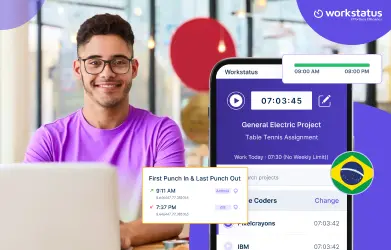Table of Contents
Introduction
Many employees have access to paid time off (PTO) or vacation days as part of their employment benefits.
Only 23% of employees utilize all of their eligible vacation time each year, often due to concerns about workload or fear of being seen as less dedicated to their jobs.
However, there’s often confusion about these terms and their differences.
Let’s understand the distinctions between PTO and vacation days, their significance, and how they impact employees and workplaces.
Let’s dive in.
What is PTO?
PTO stands for “paid time off.” It’s a versatile benefit that pools various types of leave, such as:
- Vacation days
- Sick leave
- Personal days
- Sometimes even holidays
Employees can use PTO for any purpose, whether for leisure, illness, or personal reasons.
Approximately 77% of private industry workers in the United States can avail of paid sick leave benefits, while around 80% have access to paid vacation time benefits (Bureau of Labor Statistics).
The availability and accrual of PTO vary among organizations and can depend on factors like tenure, company policy, or employment agreements.
Understanding Vacation Days
Vacation days are a subset of PTO for leisure, relaxation, and personal time away from work.
Unlike PTO, which encompasses various types of leave, vacation days are solely intended to rejuvenate and recharge.
As per the U.S. Travel Association survey, over 50% of Americans consider vacation time very important for their overall happiness.
However, statistics also reveal that a significant portion of employees do not utilize their full vacation allotment each year due to various reasons, including workload, fear of falling behind, or company culture.
The Significance of PTO and Vacation Days
1. Employee Well-being and Productivity
Research consistently demonstrates the positive correlation between taking time off and increased employee productivity.
A study conducted by Project: Time Off (U.S. Travel Association) found that employees who take their full allotted vacation days exhibit higher productivity levels, lower stress, and improved overall well-being.
Do you want to increase the productivity of your employees?
Workstatus offers a robust productivity management tool to enhance workplace efficiency.
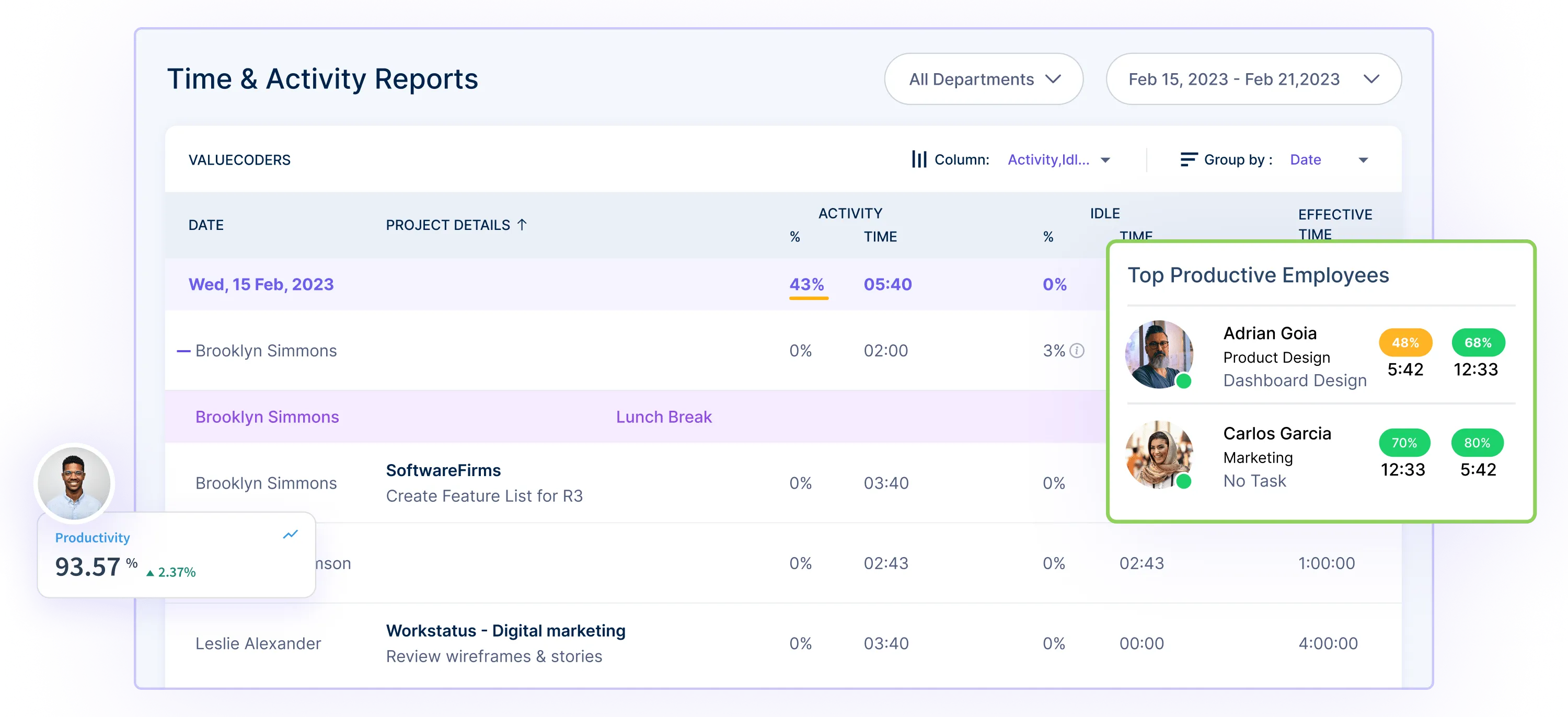
Detailed insights and analytics allow managers to monitor team performance, track task progress, and evaluate time spent on various projects.
Real-time data and reports empower teams to streamline their efforts, meet deadlines, and achieve their goals more efficiently.
2. Preventing Burnout and Stress Management
PTO and vacation days are preventive measures against burnout, a significant issue in today’s workplace.
Overworking without breaks can lead to exhaustion and reduced efficiency.
Regular time off allows individuals to recharge, reducing stress and preventing burnout.
Employees returning from vacations tend to exhibit higher levels of creativity and problem-solving skills.
3. Boosting Employee Engagement
Allowing employees to take time off positively influences their engagement levels at work.
Feeling valued and supported by employers through comprehensive leave policies enhances employee morale.
A well-rested and engaged workforce tends to be more motivated, creative, and committed, leading to increased productivity and a positive work environment.
Workstatus helps organizations keep their workforce engaged by providing real-time insights into employee activity through the following:
- Active Screenshots
- App & Website Monitoring
- Idle Time Tracker
![]()
It allows employers to monitor productivity and activity levels without micromanaging.
4. Retention and Recruitment Tool
A robust PTO and vacation day policy serves as a compelling retention and recruitment tool for organizations.
Competitive leave benefits attract top talent and contribute to retaining valuable employees.
Companies offering generous time off packages signal that they prioritize their employees’ well-being, contributing to a positive employer brand and aiding in talent retention efforts.
5. Work-Life Balance Enhancement
PTO and vacation days are instrumental in achieving a healthy balance between work and personal life.
These breaks provide opportunities for individuals to spend quality time with family, pursue hobbies, and engage in self-care activities.
Striking a balance between work responsibilities and personal time fosters a happier and more fulfilled life, positively impacting both professional and personal spheres.
Read More: 7 Tips For Mastering Workload Management
Key Differences: PTO vs. Vacation Days
Here are the major differences between PTO and Vacation days:
1. Usage Flexibility
PTO: Paid time off encompasses various types of leave like vacation, sick days, and personal time. Employees can use PTO for multiple purposes, providing flexibility to manage time off for diverse needs.
Vacation Days: These are specifically earmarked for leisure and personal time away from work. Unlike PTO, which covers various reasons for absence, vacation days are solely dedicated to relaxation and rejuvenation.
2. Accrual and Allocation
PTO: Typically accumulates over time, often increasing with tenure or according to company policies. Employees accrue PTO gradually, building up their total available leave days.
Vacation Days: Usually allocated in a lump sum at the beginning of the year or gradually accrued throughout the year. Employers might provide a fixed number of vacation days annually or based on tenure.
3. Specificity of Purpose
PTO: Versatile, allowing employees to use leave for vacation, illness, personal appointments, or any other reason requiring time off from work.
Vacation Days: Solely designated for leisure and personal time off. Unlike PTO, vacation days cannot be used for other purposes like sick leave or personal emergencies.
4. Approval and Usage Constraints
PTO: Typically involves a flexible approval process since it covers various types of leave. Employees may find it easier to use PTO without stringent constraints.
Vacation Days: Often subject to specific rules and may require advance approval or scheduling due to limited availability. Employers may impose more stringent regulations on when vacation days can be taken.
Workstatus aids in scheduling and tracking vacation days, enabling employers to set specific rules, manage availability, and streamline the approval process.
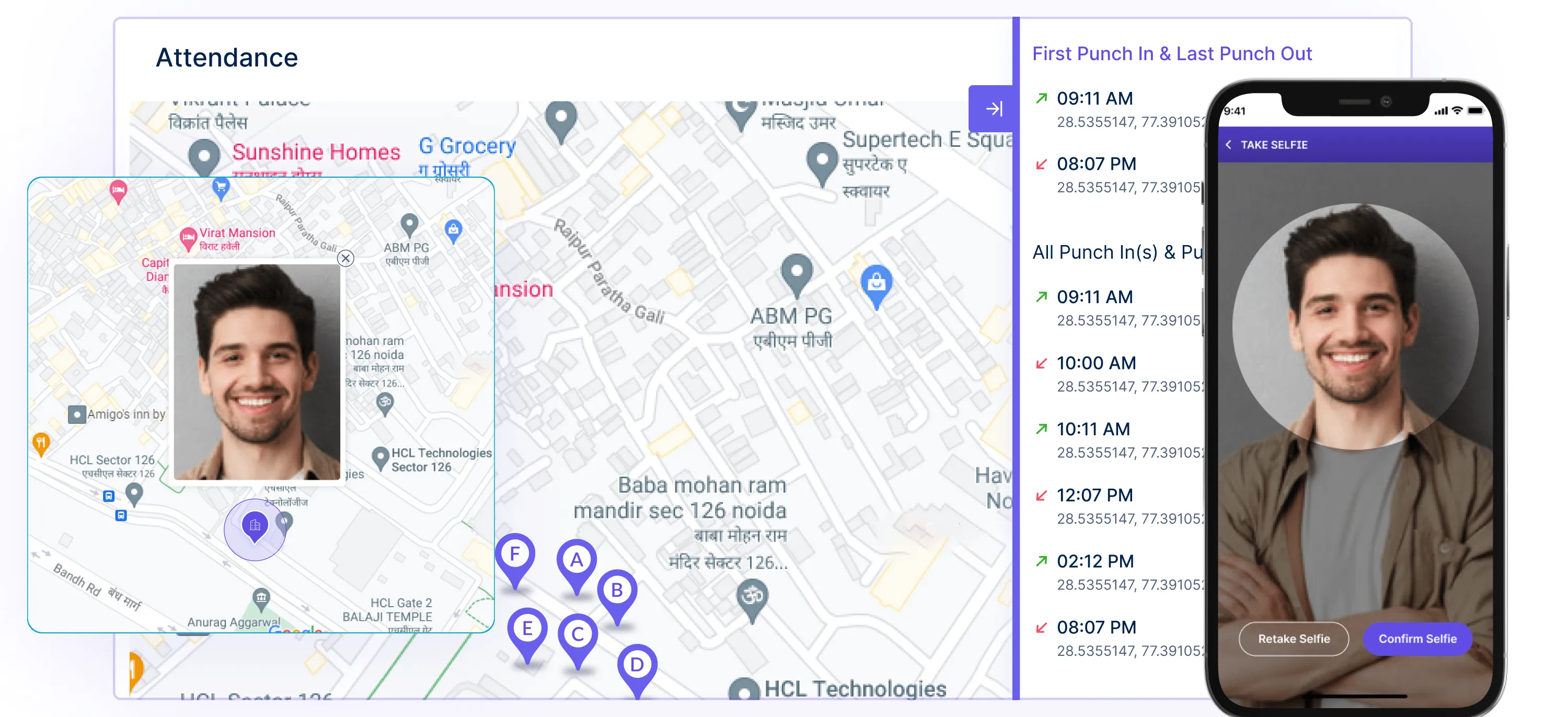
It ensures efficient utilization while adhering to imposed regulations.
5. Accumulation and Rollover Policies
PTO: This can often be accrued and carried over from one year to the next, depending on company policies. This allows employees to accumulate unused PTO for future use.
Vacation Days: Companies may have restrictions on carrying over vacation days, sometimes requiring their use within the same year to prevent accumulation.
6. Company Policies and Cultural Impact
PTO: PTO policies typically promote flexibility and trust in employees’ time management. They reflect a culture valuing work-life balance and diverse needs, allowing more freedom in taking time off as needed.
Vacation Days: Policies surrounding vacation days often enforce specific guidelines and structured scheduling. This fosters a culture emphasizing planning and coordination for time off to maintain operational continuity.
Comparison Table: PTO vs. Vacation Days
Read the table below to get a glimpse of the differences between PTO and vacation days: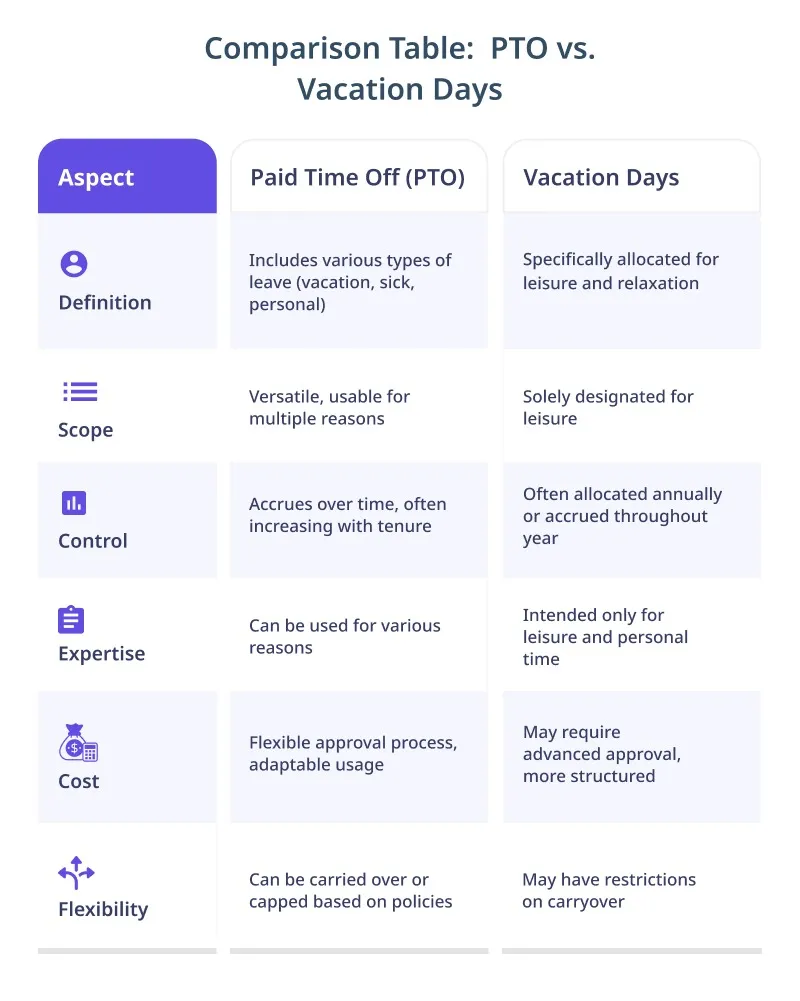 This table provides a concise overview of the primary differences between Paid Time Off (PTO) and Vacation Days in various aspects such as definition, usage, accrual, specificity, approval, accumulation policies, and their impact on a company’s policies and culture.
This table provides a concise overview of the primary differences between Paid Time Off (PTO) and Vacation Days in various aspects such as definition, usage, accrual, specificity, approval, accumulation policies, and their impact on a company’s policies and culture.
Strategies for Maximizing PTO and Vacation Days
Here are the top seven strategies for maximizing PTO and Vacation days:
1. Plan Wisely
Effective planning involves assessing your workload and team commitments.
Coordinate with colleagues to ensure coverage during your absence.
Inform supervisors and team members about your planned time off well in advance.
By strategically planning, you can anticipate potential work bottlenecks, delegate tasks, and ensure a smooth transition before taking your leave.
2. Utilize Long Weekends
Long weekends and public holidays offer extended periods without consuming excessive vacation days.
Strategically align your time off with these days to create more substantial breaks.
It’s an excellent way to extend your relaxation or travel opportunities without utilizing a considerable portion of your allotted vacation days.
3. Consider Off-Peak Periods
When planning vacations, explore off-peak times for travel.
Off-peak periods often provide cost savings on accommodations and transportation.
Additionally, fewer crowds and more availability of attractions contribute to a more relaxed and enjoyable experience during your time away.
4. Communicate Effectively
Maintaining transparent communication is vital.
Notify your team and supervisors about your planned time off, including the dates and any crucial details regarding ongoing projects or responsibilities.
Collaborate with colleagues to ensure tasks are delegated appropriately and deadlines are managed efficiently during your absence.
5. Take Short Breaks Regularly
Consider breaking up your time off into shorter increments throughout the year.
Using a day or two intermittently can provide rejuvenating breaks without exhausting your entire vacation allotment.
These short breaks enable you to recharge regularly and maintain a consistent work-life balance.
6. Explore Flexibility and Remote Work
Explore your company’s remote work policies or flexible scheduling options.
Some organizations allow employees to work remotely or adjust their schedules during their time off.
Utilizing these options could enable you to combine work and leisure, providing a more relaxed environment while still attending to essential work tasks.
Workstatus ensures seamless collaboration and accountability regardless of location or schedule adjustments.
![]()
This tool enables employees to maintain productivity while embracing a flexible work environment, helping them effectively balance work and leisure.
7. Maximize Weekends and Personal Days
Make the most of weekends and personal days by strategically planning short getaways or relaxation time.
By aligning your days with weekends or adjacent to public holidays, you can extend your time off without using a significant portion of your PTO or vacation days, maximizing your leisure opportunities.
These strategies can help you optimize your PTO and vacation days, allowing you to enjoy quality time off while maintaining productivity and a healthy work-life balance.
Tracking and Managing PTOs and Vacations with Workstatus
Workstatus, an innovative workforce management tool, offers streamlined solutions for tracking and managing Paid Time Off (PTO) and vacation days.
It simplifies the process of monitoring employee leave, ensuring efficient management of absences while maintaining productivity within organizations.
Here is how Workstatus can help you with its most advanced features:
1. Leave Request System
Workstatus provides a user-friendly interface for employees to submit leave requests effortlessly.
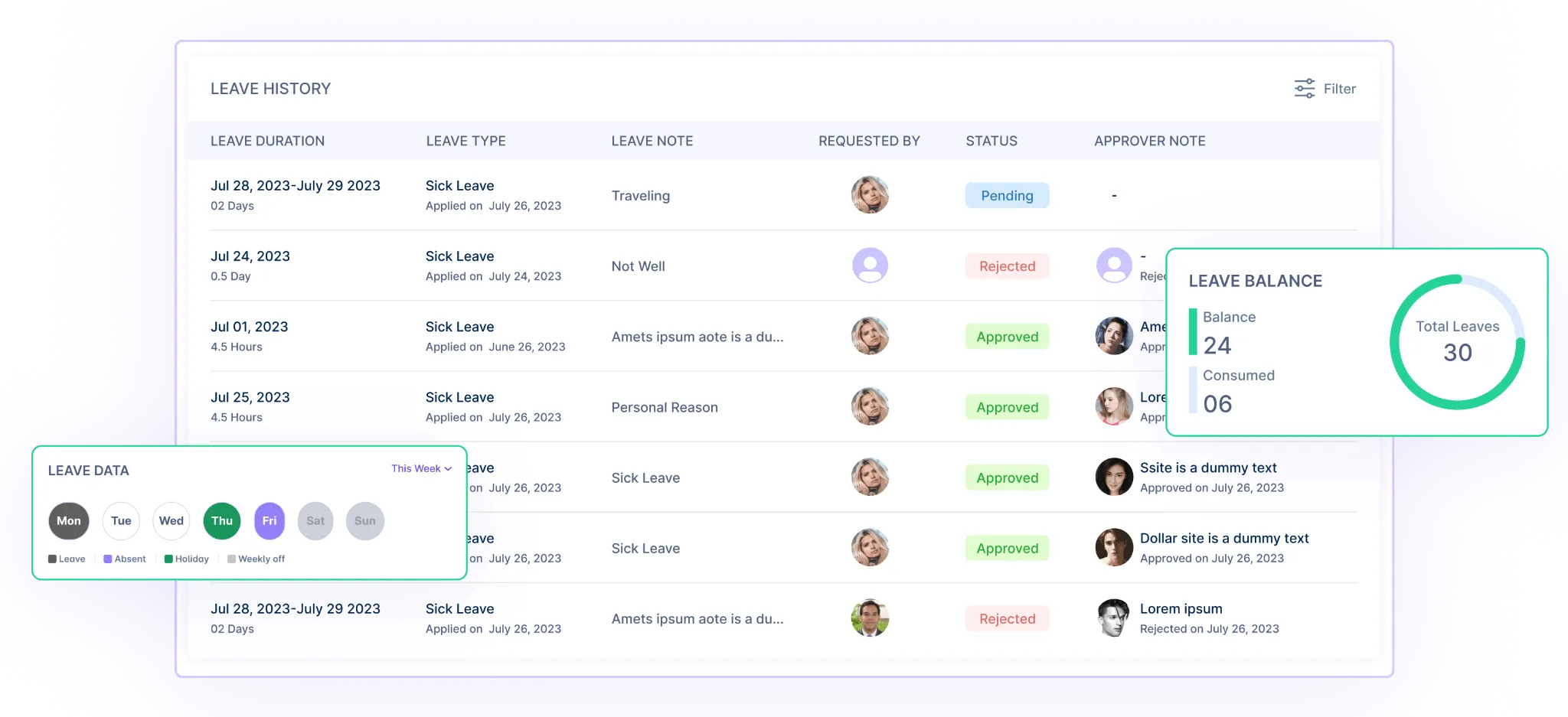
It streamlines the process, allowing employees to request time off with specific dates and reasons, facilitating quick supervisor approvals.
2. Centralized Leave Calendar
The platform offers a centralized leave calendar that showcases all approved leave requests and scheduled vacations.
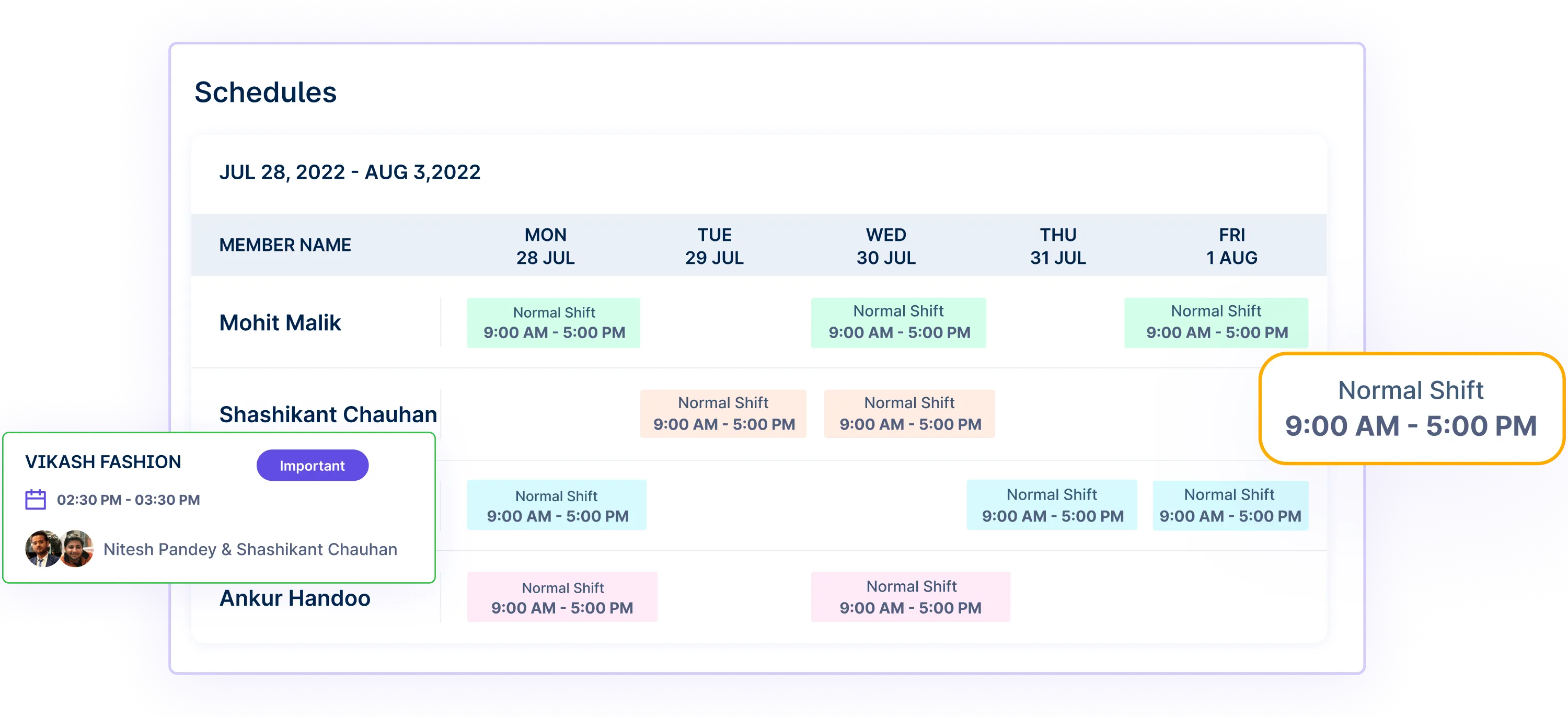
This visual representation assists managers in effectively planning workloads and ensuring adequate staffing during absences.
3. Customizable Leave Policies
Workstatus allows customization of leave policies based on company regulations.
Administrators can set accrual rates, define leave types (PTO, sick leave, vacations), and establish rules for carryovers or maximum accruals, ensuring compliance with organizational guidelines.
4. Real-time Leave Status Updates
Employees and managers receive real-time updates on leave statuses.
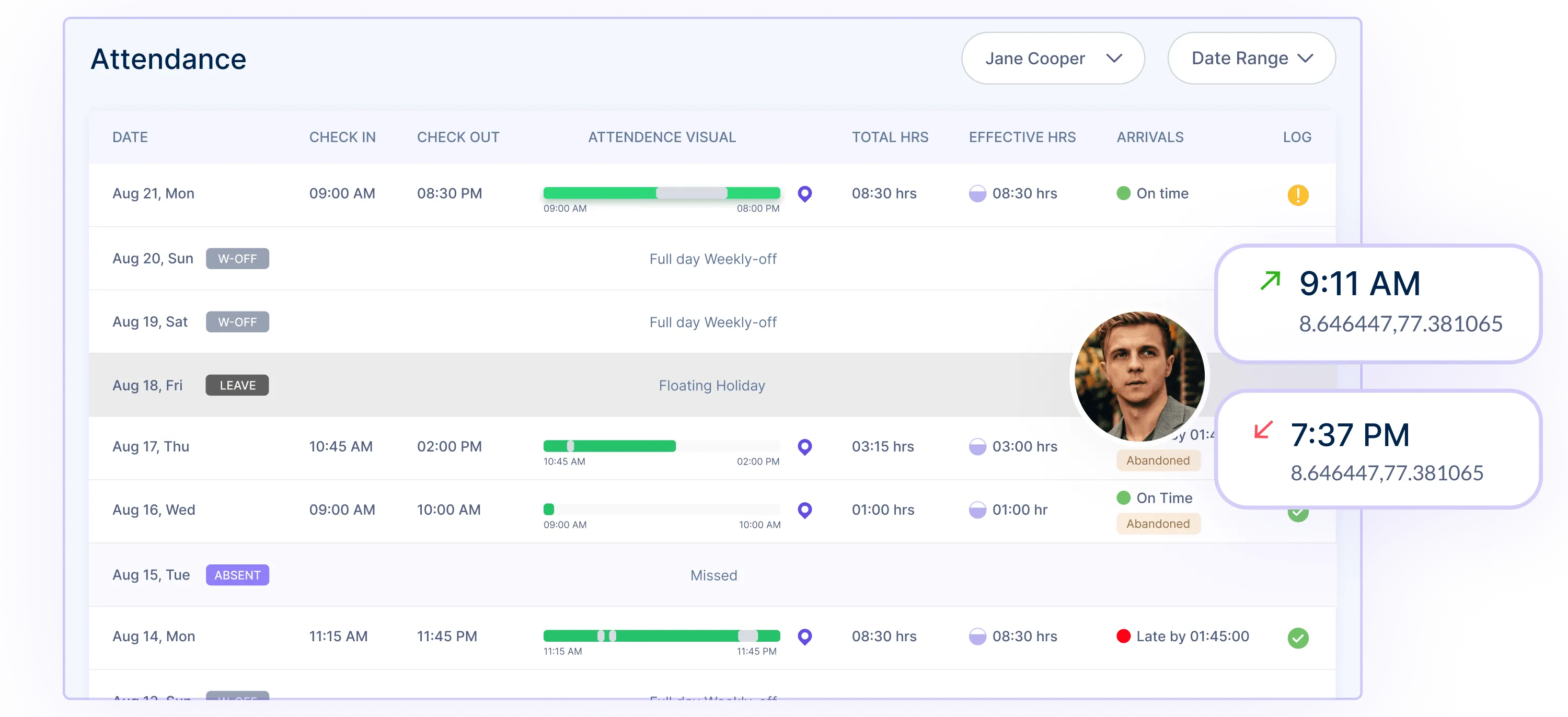
It minimizes confusion by providing instant notifications on approved, pending, or declined leave requests, enabling better coordination and planning.
5. Integration with Payroll Systems
Workstatus seamlessly integrates with payroll systems, ensuring accurate calculations of paid time off.
It automates the process, reducing manual errors and ensuring employees are compensated correctly for their leave.
6. Insightful Reporting and Analytics
The platform generates comprehensive reports and analytics on employee leave patterns, utilization rates, and trends.
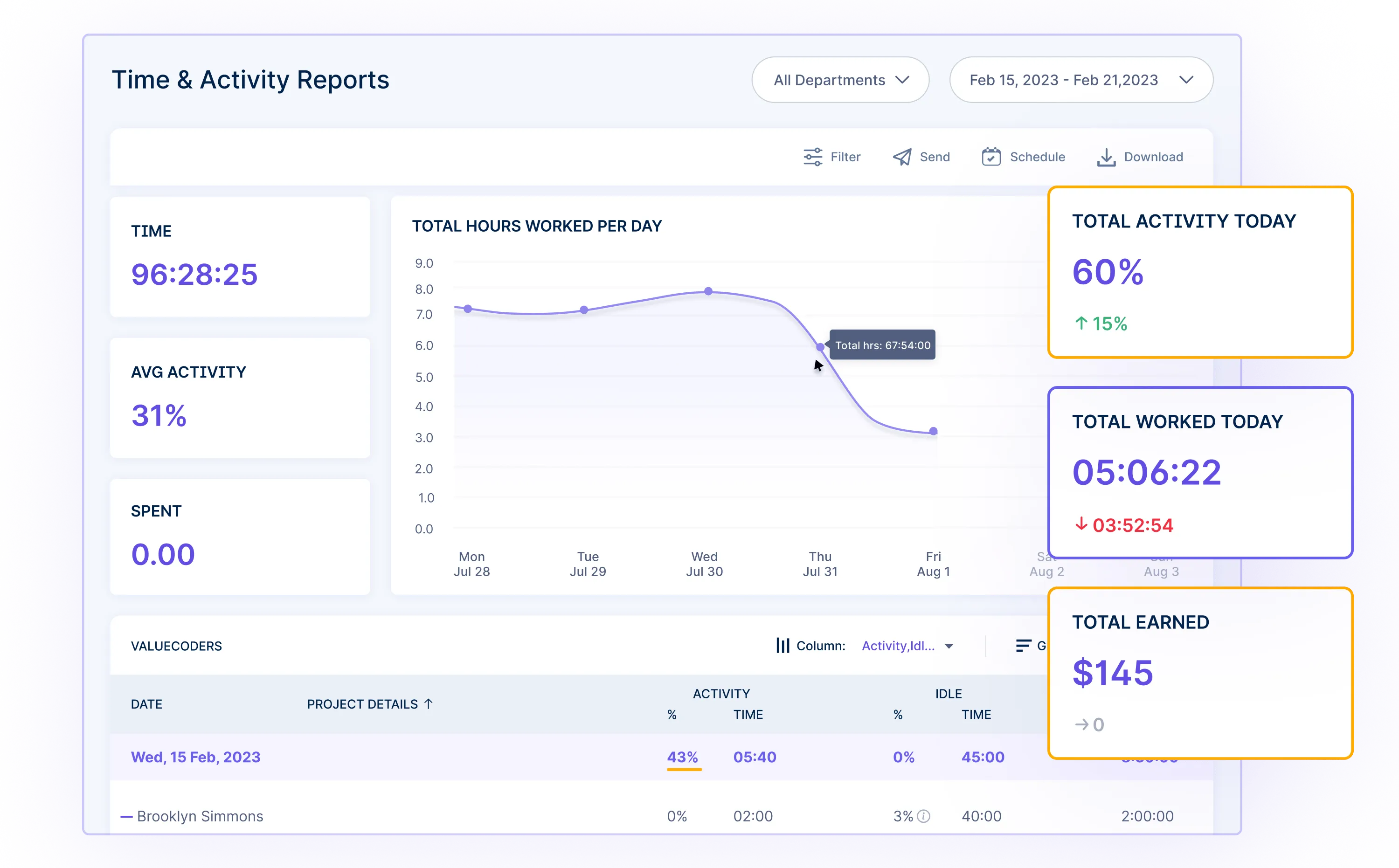
These insights aid in identifying patterns of absenteeism, facilitating better decision-making for resource allocation and workforce planning.
Workstatus simplifies and enhances the management of PTOs and vacations, providing an efficient and organized system for both employees and managers to handle leave requests and optimize workforce management.
Closing Thoughts
Understanding PTO and vacation days is crucial.
PTO covers different types of leave, like sick days and vacations, while vacation days are just for relaxing. Knowing this helps people plan their time off better.
Employers should have clear rules that suit both kinds of leave, making employees happier and work better.
Getting this right means everyone can enjoy time off and work well when they’re back.




